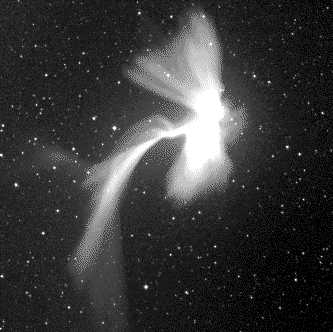
|
Credit & Copyright: ROTSE Team
Explanation:
Click on the above image and watch a
Leonid meteor explode.
The tremendous heat generated by the collision of a
small sand-bit moving at 70 kilometers/second with the
Earth's upper atmosphere causes the rock-fragment to
heat up, glow brightly, and disintegrate.
In some cases, the
meteor literally explodes leaving a
visible cloud that dissipates slowly.
The above image shows just such an explosion for a bright
meteor from the recent
Leonid Meteor Shower.
Clicking on the
above image will start a
(4.2 Megabtye) movie of thirty
1-minute exposures showing the explosion cloud dissipate.
Each movie frame, taken with the
ROTSE
telescope early 17 November, is 8 degrees across -
16 times the diameter of the full moon.
Near the middle of the sequence, a less bright
meteor moves through the field.
|
January February March April May June July August September October November December |
| |||||||||||||||||||||||||||||||||||||||||||||||||||||||
NASA Web Site Statements, Warnings, and Disclaimers
NASA Official: Jay Norris. Specific rights apply.
A service of: LHEA at NASA / GSFC
& Michigan Tech. U.
Based on Astronomy Picture
Of the Day
Publications with keywords: Leonids - meteor
Publications with words: Leonids - meteor
See also:
- APOD: 2025 August 25 Á The Meteor and the Star Cluster
- APOD: 2025 August 6 Á Meteor before Galaxy
- APOD: 2024 November 27 Á The Meteor and the Comet
- Meteor over the Bay of Naples
- Fireball over Iceland
- APOD: 2023 August 23 Á The Meteor and the Galaxy
- APOD: 2023 July 16 Á Meteor and Milky Way over the Alps
